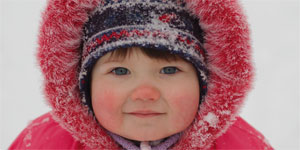
Red, dry, sore cheeks are common for little ones during winter months. For some parents, battling chronic dry skin problems such as eczema and psoriasis is a constant challenge. Be soothed – there are ways to help:
Splash around
Rub-a-dub-dub, put the kids in the tub! Dr. Irene Lara-Corrales, pediatric dermatologist at Sick Kids Hospital in Toronto, says, “Short baths on a daily basis will actually help the skin stay moist.” Keep the temperature of the water luke-warm, as hot water irritates the skin. Skip the bubbles and instead sparingly use a mild, unscented cleanser. When the bath is done done, pat them dry and apply a cream to the skin. “If you moisturize at that time, it traps water in the skin and prevents dryness.” Plus, some extra gentle massaging in of creams to their skin may mean less transferring onto pajamas.
Medicate first
“Apply doctor-prescribed treatments first, then moisturize,” says Dr. Andrea Zaenglein, professor of dermatology and pediatrics at Pennsylvania State University. This gives the medicinal ingredients the best chance to work.
Then, choose a cream
There is a difference between lotions, creams and ointments. “Lotions contain a lot of water and evaporate fast. They don’t stay in the skin long,” says Dr. Lara-Corrales. Creams are thicker and offer a better barrier for the skin. Creams are usually sold in tubs. “Applying bland emollients, like petroleum jelly can moisturize and protect against the wind and cold,” says Dr. Zaenglein. Coconut oil works well, too. Moisturizing a few times a day may be helpful for some kids with dry skin. Trying a new cream? Experiment first. Always apply a new cream to a small spot on the skin and wait to confirm it does not cause a reaction.
Try natural ingredients
Parabens, phthalates and lauryl-sulfates can sometimes irritate the skin. These ingredients are common in conventional skin creams, hand soaps, shampoos and bath gels, but are absent from most natural skin products. Someone with extra-sensitive skin may benefit from a switch in bath products. Be careful, warns Dr. Lara-Corrales, “‘Natural’ does not mean ‘safe.’” You may have to experiment with all-natural products until you find one that works.
Nourish from the inside out
“Keeping a healthy diet is good for your overall health,” says Dr. Lara-Corrales. Omega-6 and omega-3 fatty acids, found in fish, nuts and seeds, help with normal skin function. B vitamins are needed to make energy and skin cells use a lot of energy (you shed 30,000 to 40,000 skin cells each day!). Sources of B vitamins include nuts, seeds, beans and grains. Certain foods, such as gluten and soy, may exacerbate inflammatory conditions such as those of the skin. Dr. Lara-Corrales suggests parents proceed with caution when changing up a child’s diet. Take things slowly.
Don’t give up
“There is light at the end of the tunnel,” says Dr. Lara-Corrales. “At times it can be frustrating as the disease waxes and wanes. But many children will outgrow eczema.” Not sure if your child has a skin condition that needs treatment? Dr. Lara-Corrales recommends a trip to the family doc if you are concerned.
What's the problem?
Dry Skin or Eczema?
If your little one has dry skin with marked areas of redness and overlaying scales or dryness, it may be eczema. Eczema usually appears on the elbows, cheeks or knees of babies, but not usually in the diaper area. As kids grow, eczema can appear in different locations.
Eczema can be very itchy. Kids will scratch the skin and those scratches can get infected. Worst of all, itchy skin makes it hard to sleep. When a child doesn’t sleep, no one does! Dry skin in children is not just uncomfortable, but can lead to potential problems including “Infections, not sleeping well, not growing well, and not paying attention in school,” says Dr. Irene Lara-Corrales, pediatric dermatologist at Sick Kids Hospital in Toronto. “Eczema is a lot of hard work! It’s using a lot of creams and moisturizing on a regular basis, but it pays off.”
Psoriasis
Psoriasis can look like dry, red and scaly patches of skin. What causes psoriasis is unknown; however, scientists know the immune system and genetics play a factor. Usually, something triggers a flare-up causing skin cells to grow abnormally fast and build-up. “Often psoriasis can be triggered by the bacteria, Group A Streptococcus,” says Dr. Andrea Zaenglein, professor of dermatology and pediatrics at Penn State.
Triggers can also include sunburn, earache, chest cold, medication, scratches or stress. Typically, psoriasis is treated with topical corticosteroids, but light therapy or systemic treatments may also be used.
“While psoriasis is uncommon in three- and four-year-olds, it can occur,” says Dr. Zaenglein. Current estimates suggest psoriasis accounts for four percent of childhood skin disease.
Originally published in ParentsCanada magazine, February/March 2016











